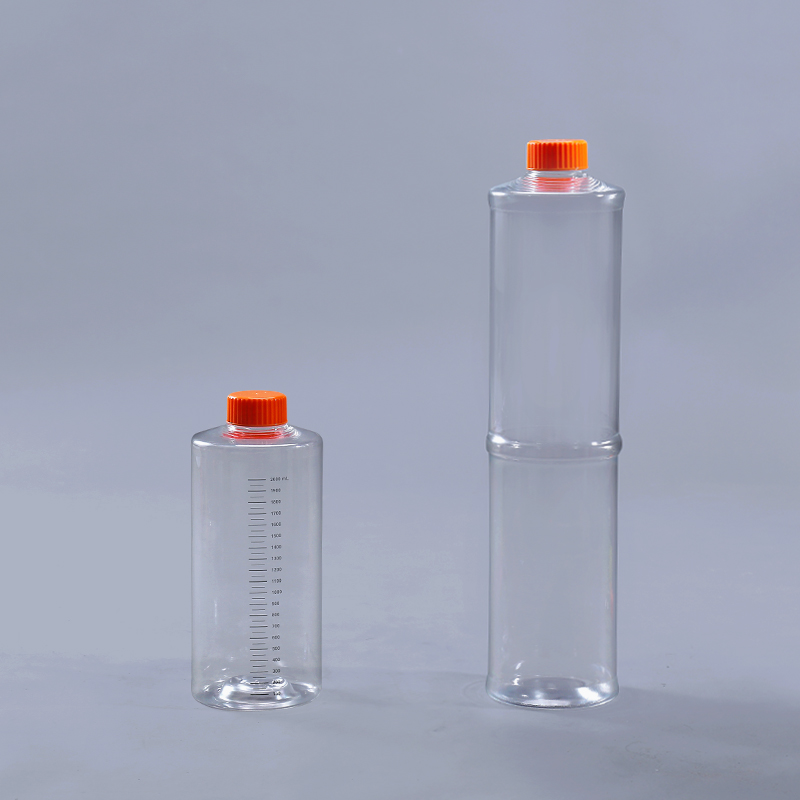, як вынікае з назвы, - гэта тып расходнага матэрыялу, які выкарыстоўваецца для культывавання клетак. З дапамогай ролікавай бутэлькі для культуры клетак яна шырока выкарыстоўваецца ў галінах клетачнай біялогіі, вірусалогіі, мікрабіялогіі і фармацэўтычнай прамысловасці.Культура клетак і тканак in vitro стала незаменнай змест у галіне навук аб жыцці. Ёсць шмат тыпаў культываваных клетак, ад вірусаў да бактэрый і грыбоў, ад клетак чалавека да клетак жывёл і клетак раслін. Некаторыя клеткі і тканіны могуць расці ў завісі, але значная колькасць клетак млекакормячых неабходна прымацаваць да паверхні, таму патрабаванні да расходных матэрыялаў для культуры клетак адносна высокія.клеткавыя ролікавыя бутэлькі
Бутэлькі з клеткавым ролікам падыходзяць для вырошчвання розных гатункаў клетак адгезійных і суспензійных клетак, такіх як клеткі Vero, клеткі HEK 293, клеткі CAR-T, MRC5, клеткі CEF, свіныя альвеалярныя макрофаги, клеткі миеломы, клеткі DF-1, клеткі ST, клеткі PK15, клеткі Marc145 і іншыя клеткі адгезійных клетак ; клеткі падвескі, такія як клеткі CHO, клеткі насякомых, клеткі BHK21 і клеткі MDCK.
Існуюць розныя тыпы расходных матэрыялаў для культуры клетак. Бутэлькі з сотавым ролікам - толькі адна з іх. Высокаэфектыўныя колбы, фабрыкі клетак, пласціны для культывавання клетак, посуд для бактэрыяльных культур і г.д. - усё гэта расходныя матэрыялы для клетак. Кожны расходны матэрыял заснаваны на патрабаваннях да выкарыстання і метадах вырошчвання клетак. Адпавядаючы розным спецыфікацыям і матэрыялам, ён з'яўляецца неабходным элементам у працэсе культуры клетак.
There are various types of consumables for cell culture. Cell roller bottles are just one of them. High-efficiency shake flasks, cell factories, cell culture plates, bacterial culture dishes, etc. are all cell consumables. Each consumable is based on usage requirements and cell culture methods. Corresponding to different specifications and materials, it is an essential item in the cell culture process.
The FAI climbed 5.9 percent year-on-year in the first 11 months of 2018, quickening from the 5.7-percent growth in Jan-Oct, the National Bureau of Statistics (NBS) said Friday in an online statement.
The key indicator of investment, dubbed a major growth driver, hit the bottom in August and has since started to rebound steadily.
In the face of emerging economic challenges home and abroad, China has stepped up efforts to stabilize investment, in particular rolling out measures to motivate private investors and channel funds into infrastructure.
Friday's data showed private investment, accounting for more than 60 percent of the total FAI, expanded by a brisk 8.7 percent.
NBS spokesperson Mao Shengyong said funds into weak economic links registered rapid increases as investment in environmental protection and agriculture jumped 42 percent and 12.5 percent respectively, much faster than the average.
In breakdown, investment in high-tech and equipment manufacturing remained vigorous with 16.1-percent and 11.6-percent increases respectively in the first 11 months. Infrastructure investment gained 3.7 percent, staying flat. Investment in property development rose 9.7 percent, also unchanged.
 English
English



















































